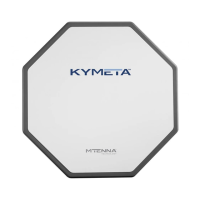© 2019 Kymeta Corporation and its affiliates. 5 08 March 2019
Kymeta™ u7 terminal usermanual
3 Physical connection interfaces
The Kymeta u7 terminal includes the following physical connection interfaces:
ODU interface cable
TX cable
RX cable
LNB-to-antenna cable
Ethernet cable
Refer to Appendix A:Specification for more information.
3.1 ODUinterface cable
Kymeta requires using only the ODU Interface cable supplied by Kymeta. Standard lengths are available up to 15.2 m
(50.0 ft.).
This cable connects the I/O box to the antenna and BUC. It provides power, Ethernet connectivity, and recovery
functionality for the antenna. It also provides power and communication for the BUC.
This cable has three different connectors:
31-pin connector—connects to the 31-pin receptacle on the back of the antenna
12-pin Amphenol connector—connects to the 12-pin receptacle on the BUC
18-pin connector at the end of the long tail—connects to the I/O box
3.2 TX cable
This N-type IF cable connects the BUC in the ODU to the TX Out of the modem within the IDU. The TX cable works in the
frequency range from 1050 MHz to 1700 MHz and passes a 10 MHz reference signal to the BUC. This protocol and the
cabling is dependent on the specific modem and BUC used for each solution. Kymeta provides an N-type to F-type
adapter to connect this cable to the modem.
3.3 RXcable
This N-type IF cable sends the L-Band (950 MHz to 2150 MHz) signal from the antenna to the modem and provides DC
power for the LNB. It connects the antenna RX OUT port to the modem primary RX IN port (Rx 1). The RX cable works in
the frequency range from 950 MHz to 2150 MHz and provides power for the LNB. Kymeta provides an N-type to F-type
adapter to connect this cable to the modem.
3.4 LNB-to-antenna cable
This cable connects the LNB to the antenna RX IN port. By default Kymeta provides a 0.3 m (12.0 in.) LMR-195 cable,
with a right-angle N-type connector. The connector is hex and knurl at each end. This cable comes attached to the ODU
mechanical assembly.

